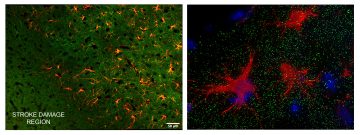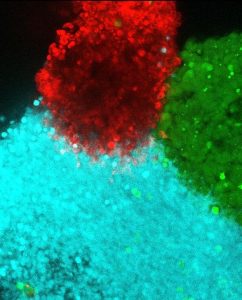(1) CX43 AND PANX1 IN STROKE
Ischemic stroke is a leading cause of mortality and disability worldwide; developing new approaches to therapy is critical. A novel therapeutic avenue we have focused on relates to cellular effects mediated by gap junction proteins which are prevalent in the astrocytes of the CNS and make unique intercellular channels and hemichannels. These channels provide a substrate for therapeutic strategies targeted to astrocytes rather than neurons, based on the premise that both cell types play critical roles in stroke recovery. It is envisioned that a therapeutic approach combining neuronal signaling pathways with astrocyte mediated events should enhance protection following stroke.
(2) CX43 IN GLIOMA
The presence of reactive astrocytes with increased Cx43 expression is a universal feature in various brain pathologies. We are interested in a scaffold-free 3D tissue culture to examine the invasion of glioma cells into neural-like tissue. We developed a system in which we could model the invasion of human glioma cells into mouse neural progenitor cell-derived spheroids. We show that we can follow invasion of human tumor cells using cell-tracking dyes and 3D laser scanning confocal microscopy in real time. Our scaffold-free 3D approach has broad applicability, as we were easily able to examine invasion using different neural progenitor cell lines, thus mimicking differences that might be observed in patient brain tissue. These results, once applied to iPSC-derived cerebral organoids that incorporate the somatic genetic variability of patients, offer the promise of truly personalized treatments for brain cancer.
(3) PANX2 IN MITOCHONDRIAL SIGNALING
Mitochondria are the energy power house of the cells and their dyfunction has been linked to many diseases. We attempt to decipher the role of a new channel in the regulation of mitochondrial calcium homeostasis. In particular, we focus on pannexin2, an atypical gap junction protein. Our preliminary findings suggests this protein has an unexpected and novel function compared to traditional gap junctions, which have been the focus of my research program, especially in the area of astrocytes and brain function. Our finding will present a significant step towards demonstrating the intracellular channel proteins, in addition to their well established role in intercellular communcation, also play a signnificant role in mitochondrial functions.

